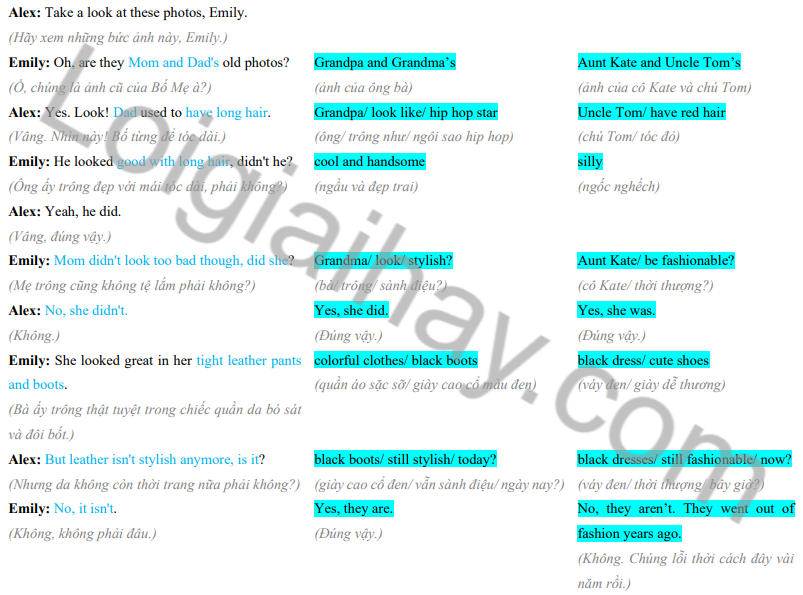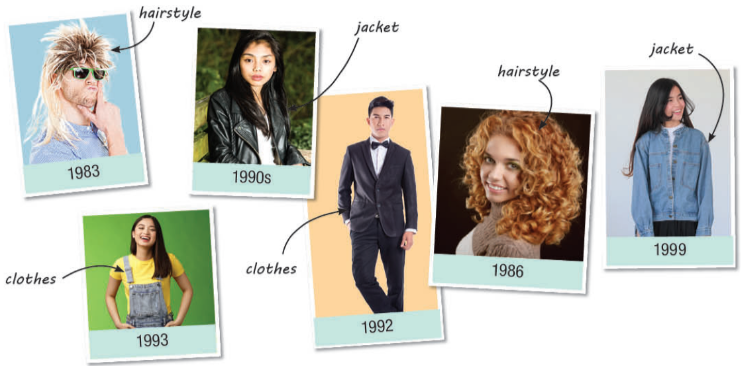Tiếng Anh 11 Unit 2 Lesson 1Let’s Talk! In pairs: Look at the picture. Why does the mom look upset with her daughter? What kinds of things do you and your parents sometimes disagree about? New Words a. Add more words to the list, then complete sentences 1-6 with the bold words. Listen and repeat. b. In pairs: Use the words in Task a to describe the pictures. Which styles do you like? Why? Listening a. Listen to a podcast about fashion in the past. What is the main focus of the talk? b. Now, listen and fill in the blanks GÓP Ý HAY - NHẬN NGAY QUÀ CHẤT Gửi góp ý cho HocTot.Nam.Name.Vn và nhận về những phần quà hấp dẫn
Lựa chọn câu để xem lời giải nhanh hơn
Let's Talk! Video hướng dẫn giải In pairs: Look at the picture. Why does the mom look upset with her daughter? What kinds of things do you and your parents sometimes disagree about? (Theo cặp: Nhìn vào bức tranh. Tại sao người mẹ có vẻ khó chịu với con gái mình? Đôi khi bạn và bố mẹ bạn không đồng ý với nhau về những điều gì?)
Lời giải chi tiết: The mother seems annoyed with her daughter because of her hair color and behavior. (Người mẹ có vẻ khó chịu với con gái mình vì màu tóc và thái độ ứng xử của cô ấy.) Sometimes, my parents and I disagree on our dress style, opinions, habits, and behavior. (Đôi khi, tôi và bố mẹ mình không đồng ý với nhau về phong cách ăn mặc, quan điểm, thói quen và cách ứng xử.) New Words a Video hướng dẫn giải a. Add more words to the list, then complete sentences 1-6 with the bold words. Listen and repeat. (Thêm các từ khác vào danh sách, sau đó hoàn thành câu 1-6 với các từ in đậm. Lắng nghe và lặp lại.)
1. My shoes are very comfortable and _______________. People always ask me where I got them. 2. Headscarves are a new _______________ this year. You'll see many girls and women wearing scarves. 3. These clothes look so _______________. I don't know who would buy them. People will laugh at them. 4. Many women's shoe designs aren't _______________. Your feet will hurt if you wear them all day. 5. On Tết holiday, you should wear a shirt that is _______________ for visiting your relative's house. 6. I don't wear _____________ because I don't think animals should be hurt to make clothes. Lời giải chi tiết:
1. stylish (adj): sành điệu, phong cách My shoes are very comfortable and stylish. People always ask me where I got them. (Giày của tôi rất thoải mái và phong cách. Mọi người luôn hỏi tôi lấy chúng ở đâu.) 2. trend (n): xu hướng Headscarves are a new trend this year. You'll see many girls and women wearing scarves. (Khăn trùm đầu là một xu hướng mới trong năm nay. Bạn sẽ thấy nhiều cô gái và phụ nữ đeo khăn quàng cổ.) 3. silly (adj): ngớ ngẩn These clothes look so silly. I don't know who would buy them. People will laugh at them. (Những bộ quần áo này trông thật ngớ ngẩn. Tôi không biết ai sẽ mua chúng. Mọi người sẽ cười nhạo họ.) 4. practical (adj): thiết thực Many women's shoe designs aren't practical. Your feet will hurt if you wear them all day. (Nhiều thiết kế giày của phụ nữ không thực tế. Bàn chân của bạn sẽ bị đau nếu bạn mang chúng cả ngày.) 5. suitable (adj): phù hợp On Tết holiday, you should wear a shirt that is suitable for visiting your relative's house. (Vào ngày Tết, bạn nên mặc một chiếc áo phù hợp để đến thăm nhà họ hàng của bạn.) 6. leather (n): da I don't wear leather because I don't think animals should be hurt to make clothes. (Tôi không mặc đồ da vì tôi không nghĩ rằng động vật nên bị tổn thương để làm quần áo.) New Words b Video hướng dẫn giải b. In pairs: Use the words in Task a to describe the pictures. Which styles do you like? Why? (Theo cặp: Sử dụng các từ trong Bài a để mô tả các bức tranh. Bạn thích phong cách nào? Tại sao?) I think the girl wearing sunglasses looks stylish. (Tôi nghĩ rằng cô gái đeo kính râm trông sành điệu.)
Lời giải chi tiết: - I think the man wearing a floral shirt inside and a vest outside looks silly. (Tôi nghĩ rằng người đàn ông mặc áo sơ mi hoa bên trong, áo vest bên ngoài trông rất ngớ ngẩn.) - I think the man with long hair looks very comfortable. (Tôi nghĩ người đàn ông tóc dài trông rất thoải mái.) - I think the girl in the leather jacket looks very trendy. (Tôi nghĩ cô gái mặc áo da trông rất xu hướng.) - I like the style of the girl in the leather jacket because that style looks both stylish and trendy. (Tôi thích phong cách của cô gái mặc áo da. Vì phong cách đó trông vừa sành điệu, vừa bắt kịp xu hướng.) Listening a Video hướng dẫn giải a. Listen to a podcast about fashion in the past. What is the main focus of the talk? (Nghe một podcast về thời trang trong quá khứ. Trọng tâm chính của bài nói chuyện là gì?) 1. popular fashion trends (xu hướng thời trang phổ biến) 2. silly fashion trends (xu hướng thời trang ngớ ngẩn) Phương pháp giải: Bài nghe: Chris: Rachel, look at this! Rachel: Chris! What are you wearing? Are you going to a 70s party? Chris: Haha, no, I'm not. It's because today we're talking about fashion trends in the past. Rachel and Chris: Welcome to Fashion Dive Podcast. Rachel: This is Rachel. Chris: And I'm Chris. Rachel: You know, younger generations often make fun of older generations' fashion. Chris: Yes. But fashion trends often come back. A lot of what they wear is actually old trends. Rachel: Right. Like the miniskirt. Chris: Yes. It was invented in the 1960s. A British fashion designer experimented with shorter skirts, and it became a huge trend. It was one of the greatest inventions in the fashion world, wasn't it? Rachel: Yep! Chris: Now, take a look at these photos. They're so stylish, aren't they? Rachel: Erm... yes. Chris: A big trend in the 1970s was bell-bottoms. And I'm wearing those, in case you haven't noticed. They had large leg openings from the knees down. The openings could be as wide as sixty-six centimeters. Rachel: In the 1980s, women entered the workforce in large number and they wanted to look powerful. This was known as "power dressing," and shoulder pads were a big part of it. Chris: Many trends in the 80s were silly but not this one. Power dressing sounds really cool, doesn't it? Rachel: Yes, it does. Chris: Fashion in the 1990s … Tạm dịch: Chris: Rachel, nhìn này! Rachel: Chris! Bạn đang mặc gì? Bạn sẽ đến một bữa tiệc thập niên 70? Chris: Haha, không, tôi không. Đó là bởi vì hôm nay chúng ta đang nói về xu hướng thời trang trong quá khứ. Rachel và Chris: Chào mừng đến với Fashion Dive Podcast. Rachel: Đây là Rachel. Chris: Và tôi là Chris. Rachel: Bạn biết đấy, thế hệ trẻ thường chế giễu thời trang của thế hệ cũ. Chris: Vâng. Nhưng xu hướng thời trang thường quay trở lại. Rất nhiều những gì họ mặc thực sự là xu hướng cũ. Rachel: Đúng. Giống như váy ngắn. Chris: Vâng. Nó được phát minh vào những năm 1960. Một nhà thiết kế thời trang người Anh đã thử nghiệm với những chiếc váy ngắn hơn và nó đã trở thành một xu hướng lớn. Đó là một trong những phát minh vĩ đại nhất trong thế giới thời trang, phải không? Rachel: Đúng! Chris: Bây giờ, hãy xem những bức ảnh này. Chúng thật sành điệu phải không nào? Rachel: Ờ... vâng. Chris: Một xu hướng lớn trong những năm 1970 là quần ống loe. Và tôi đang mặc những thứ đó, trong trường hợp bạn không nhận thấy. Họ có những lỗ chân lớn từ đầu gối trở xuống. Các lỗ có thể rộng tới sáu mươi sáu cm. Rachel: Vào những năm 1980, số lượng lớn phụ nữ tham gia lực lượng lao động và họ muốn trông có vẻ quyền lực. Điều này được gọi là "mặc quần áo quyền lực" và miếng đệm vai là một phần quan trọng trong đó. Chris: Nhiều xu hướng trong những năm 80 thật ngớ ngẩn nhưng xu hướng này thì không. Thay đồ năng lượng nghe thật tuyệt phải không? Rachel: Vâng, đúng vậy. Chris: Thời trang những năm 1990… Lời giải chi tiết: The main focus of the talk is: 1. popular fashion trends (Trọng tâm chính của buổi nói chuyện là: xu hướng thời trang phổ biến) Listening b Video hướng dẫn giải b. Now, listen and fill in the blanks. (Bây giờ, hãy lắng nghe và điền vào chỗ trống.)
1. The miniskirt was invented in the ____________. 2. The speakers both think that the ______________ was one of the greatest inventions in the fashion world. 3. Bell-bottoms could have legs opening up to _____________ centimeters. 4. A trend in the ______________ was "power dressing." Women wore shoulder pads to look powerful. 5. Rachel agrees that, ________________ sounds really cool. Lời giải chi tiết:
1. The miniskirt was invented in the 1960s. (Chiếc váy ngắn được phát minh vào những năm 1960.) Thông tin: Rachel: Right. Like the miniskirt. (Đúng. Giống như váy ngắn.) Chris: Yes. It was invented in the 1960s. (Vâng. Nó được phát minh vào những năm 1960.) 2. The speakers both think that the miniskirt was one of the greatest inventions in the fashion world. (Cả hai diễn giả đều nghĩ rằng chiếc váy ngắn là một trong những phát minh vĩ đại nhất trong thế giới thời trang.) Thông tin: Chris: Yes. It was invented in the 1960s. A British fashion designer experimented with shorter skirts, and it became a huge trend. It was one of the greatest inventions in the fashion world, wasn't it? (Vâng. Nó được phát minh vào những năm 1960. Một nhà thiết kế thời trang người Anh đã thử nghiệm với những chiếc váy ngắn hơn và nó đã trở thành một xu hướng lớn. Đó là một trong những phát minh vĩ đại nhất trong thế giới thời trang, phải không?) Rachel: Yep! (Đúng!) 3. Bell-bottoms could have legs opening up to 66 centimeters. (Quần ống loe có thể mở rộng chân đến 66 cm.) Thông tin: Chris: A big trend in the 1970s was bell-bottoms. And I'm wearing those, in case you haven't noticed. They had large leg openings from the knees down. The openings could be as wide as sixty-six centimeters. (Một xu hướng lớn trong những năm 1970 là quần ống loe. Và tôi đang mặc những thứ đó, trong trường hợp bạn không nhận thấy. Họ có những lỗ chân lớn từ đầu gối trở xuống. Các lỗ có thể rộng tới sáu mươi sáu cm.) 4. A trend in the 1980s was "power dressing." Women wore shoulder pads to look powerful. (Một xu hướng trong những năm 1980 là "mặc quần áo quyền lực". Phụ nữ mặc miếng đệm vai để trông mạnh mẽ.) Thông tin: Rachel: In the 1980s, women entered the workforce in large number and they wanted to look powerful. This was known as "power dressing," and shoulder pads were a big part of it. (Vào những năm 1980, số lượng lớn phụ nữ tham gia lực lượng lao động và họ muốn trông có vẻ quyền lực. Điều này được gọi là "mặc quần áo quyền lực" và miếng đệm vai là một phần quan trọng trong đó.) 5. Rachel agrees that, power dressing sounds really cool. (Rachel đồng ý rằng, trang phục mạnh mẽ nghe rất tuyệt.) Thông tin: Chris: Many trends in the 80s were silly but not this one. Power dressing sounds really cool, doesn't it? (Nhiều xu hướng trong những năm 80 thật ngớ ngẩn nhưng xu hướng này thì không. Trang phục mạnh mẽ nghe thật tuyệt phải không?) Rachel: Yes, it does. (Vâng, đúng vậy.) Listening c Video hướng dẫn giải c. Read the Conversation Skill box. Then, listen and repeat. (Đọc hộp Kỹ năng đàm thoại. Sau đó, nghe và lặp lại.)
Listening d Video hướng dẫn giải d. Now, listen to the podcast again and circle the phrase you hear. (Bây giờ, hãy nghe lại podcast và khoanh tròn cụm từ bạn nghe được.) Lời giải chi tiết: Take a look at (these photos). (Hãy xem (những bức ảnh này).) Listening e Video hướng dẫn giải e. In pairs: What do you think of the trends discussed in the podcast? (Theo cặp: Bạn nghĩ gì về các xu hướng được thảo luận trong podcast?) Lời giải chi tiết: The trends discussed in the podcast are really interesting. These trends show the diversity, richness in styles and fashion perspectives at different periods. (Các xu hướng được thảo luận trong podcast thực sự rất thú vị. Những xu hướng này cho thấy sự đa dạng, phong phú trong phong cách và quan điểm thời trang ở các giai đoạn khác nhau.) Grammar Meaning & Use a Video hướng dẫn giải a. Look at the picture. What do you think the girls are saying? (Nhìn vào bức tranh. Bạn nghĩ các cô gái đang nói gì?)
Lời giải chi tiết: This looks good, doesn’t it? (Cái này có vẻ tốt, phải không?) Yes, it does. (Đúng vậy.) Grammar Meaning & Use b Video hướng dẫn giải b. Now, listen and check your ideas. (Bây giờ, hãy lắng nghe và kiểm tra ý tưởng của bạn.) Lời giải chi tiết: Girl 1: This looks good, doesn’t it? (Cái này có vẻ tốt, phải không?) Girl 2: Yes, it does. (Đúng vậy.) Grammar Meaning & Use c Video hướng dẫn giải c. Listen and repeat. (Lắng nghe và lặp lại.)
This looks good, doesn’t it? (Cái này có vẻ tốt, phải không?) Yes, it does. (Đúng vậy.) Grammar Form & Practice a Video hướng dẫn giải a. Fill in the blanks with the correct tag questions and responses. (Điền vào chỗ trống với các câu hỏi và câu trả lời chính xác.) 1. A: The 1970s had the best music, didn't it? B: No, it didn't. 80s music was much better. 2. A: Men's fashion in the 1970s wasn't very good, ______________? B: _________________ , it wasn't. It was very boring. 3. A: Teens like to follow the latest trends, ________________? B: Yes, __________________.They always want the latest fashions. 4. A: We didn't have the best hairstyles back then, _________________? B: No, ______________. Hairstyles looked silly in those days. 5. A: He likes wearing practical clothes, ______________? B: Yes, __________________. 6. A: Alice is really interested in fashion, __________________? B: Yes, ___________________. She always buys new clothes. Phương pháp giải:
Lời giải chi tiết:
1. A: The 1970s had the best music, didn't it? (Những năm 1970 có âm nhạc hay nhất phải không?) B: No, it didn't. 80s music was much better. (Không. Âm nhạc thập niên 80 hay hơn nhiều.) 2. A: Men's fashion in the 1970s wasn't very good, was it? (Thời trang nam những năm 1970 không đẹp lắm đúng không?) B: No, it wasn't. It was very boring. (Không, không phải đâu. Nó rất nhàm chán.) 3. A: Teens like to follow the latest trends, don’t they? (Thanh thiếu niên thích chạy theo những xu hướng mới nhất phải không?) B: Yes, they do.They always want the latest fashions. (Vâng. Họ luôn muốn có thời trang mới nhất.) 4. A: We didn't have the best hairstyles back then, did we? (Hồi đó chúng ta không có những kiểu tóc đẹp nhất phải không?) B: No, we didn’t. Hairstyles looked silly in those days. (Không. Kiểu tóc trông ngớ ngẩn trong những ngày đó.) 5. A: He likes wearing practical clothes, doesn’t he? (Anh ấy thích mặc quần áo tiện lợi phải không?) B: Yes, he does. (Vâng, đúng vậy.) 6. A: Alice is really interested in fashion, isn’t she? (Alice thực sự quan tâm đến thời trang phải không?) B: Yes, she is. She always buys new clothes. (Vâng. Cô ấy luôn luôn mua quần áo mới.) Grammar Form & Practice b Video hướng dẫn giải b. Complete the questions using the prompts, then answer the questions. (Hoàn thành các câu hỏi bằng cách sử dụng các gợi ý, sau đó trả lời các câu hỏi.) 1. A: Their clothes were silly, weren't they? (past-be/silly) B: No, they weren't. 2. A: She ____________________, __________________? (now-look/stylish) B: ______________________________________ 3. A: Those jeans ___________________, _________________? (now-be/too short) B: _______________________________________ 4. A: She ____________________with short hair, ___________________? (past-look/good) B: ________________________________________ 5. A: Those leather boots ___________________, __________________? (now not be/stylish) B: ___________________________________ 6. A: Those jeans ____________________for girls, _________________? (now-be/suitable) B: ____________________________________ Lời giải chi tiết: 1. A: Their clothes were silly, weren’t they? (Quần áo của họ thật ngớ ngẩn phải không?) B: No, they weren’t. (Không.) 2. A: She looks stylish, doesn’t she? (Cô ấy trông sành điệu phải không?) B: Yes, she does. (Vâng, đúng vậy.) 3. A: Those jeans are too short, aren’t they? (Những chiếc quần jean đó quá ngắn phải không?) B: Yes, they are. (Đúng vậy.) 4. A: She looked good with short hair, didn’t she? (Cô ấy trông đẹp với mái tóc ngắn, phải không?) B: Yes, she did. (Vâng, đúng vậy.) 5. A: Those leather boots aren’t stylish, are they? (Những đôi bốt da đó không sành điệu phải không?) B: No, they aren’t. (Không.) 6. A: Those jeans are suitable for girl, aren’t they? (Những chiếc quần jean đó phù hợp với con gái phải không?) B: No, they aren’t. (Không.) Grammar Form & Practice c Video hướng dẫn giải c. In pairs: Make comments on the pictures on page 14 and see if your friend can guess which picture you're commenting on. (Làm theo cặp: Đưa ra các nhận xét về bức tranh ở trang 14 và xem bạn của bạn có đoán được bạn đang nhận xét bức tranh nào không.) The woman's outfit is very stylish, isn't it? (Trang phục của người phụ nữ rất phong cách phải không?) Lời giải chi tiết: A: The woman's outfit is very stylish, isn't it? (Trang phục của người phụ nữ rất phong cách phải không?) B: Yes, it is. It has the style of the 1980s. (Vâng, đúng vậy. Nó mang phong cách của những năm 1980.) A: The men's outfits look very trendy, isn’t it? (Trang phục của người đàn ông trông rất xu hướng phải không?) B: No, it isn’t. His outfit looks so colorful. (Không. Trang phục của anh ta trông thật sặc sỡ.) Pronunciation a Video hướng dẫn giải a. Intonation falls at the end of question tags used to confirm agreement. (Ngữ điệu rơi ở cuối câu hỏi đuôi dùng để khẳng định sự đồng ý.) That's a pretty skirt, isn't it? (Đó là một chiếc váy đẹp, phải không?) She doesn't look good, does she? (Cô ấy trông không ổn, phải không?) Pronunciation b Video hướng dẫn giải b. Listen to the sentences and notice how the intonation falls. (Nghe các câu và để ý ngữ điệu rơi như thế nào.) Mom looked very stylish, didn't she? (Mẹ trông rất sành điệu phải không?) It isn't very expensive, is it? (Nó không phải là rất tốn kém, phải không?) Pronunciation c Video hướng dẫn giải c. Listen and cross out the sentence with the wrong intonation. (Nghe và gạch bỏ câu có ngữ điệu sai.) That trend wasn't very practical, was it? (Xu hướng đó không thực tế lắm phải không?) This dress is a bit short, isn't it? (Chiếc váy này hơi ngắn phải không?) Lời giải chi tiết: This dress is a bit short, isn't it? (Chiếc váy này hơi ngắn phải không?) => Wrong. Intonation rises. (Sai. Ngữ điệu tăng lên.) Pronunciation d Video hướng dẫn giải d. Read the sentences with the correct intonation to a partner. (Đọc các câu với ngữ điệu chính xác cho bạn.) Practice a Video hướng dẫn giải a. Practice the conversation. Swap roles and repeat. (Thực hành các cuộc đối thoại. Trao đổi vai trò và lặp lại.)
Practice b Video hướng dẫn giải b. Make two more conversations using the ideas on the right. (Thực hiện thêm hai cuộc hội thoại bằng cách sử dụng các ý tưởng bên phải.) Lời giải chi tiết: 1. Alex: Take a look at these photos, Emily. (Hãy xem những bức ảnh này, Emily.) Emily: Oh, are they Grandpa and Grandma’s old photos? (Ồ, đó có phải là những bức ảnh cũ của Ông và Bà không?) Alex: Yes. Look! Grandpa used to look like a hip hop star. (Vâng. Nhìn này! Ông nội trông giống như một ngôi sao hip hop.) Emily: He looked cool and handsome, didn't he? (Ông trông ngầu và đẹp trai phải không?) Alex: Yeah, he did. (Vâng, đúng vậy.) Emily: Grandma looked stylish, didn’t she? (Bà trông sành điệu phải không?) Alex: Yes, she did. (Vâng, đúng vậy.) Emily: She looked great in her colorful clothes and black boots. (Bà trông thật tuyệt trong chiếc áo choàng đầy màu sắc và đôi bốt đen.) Alex: But black boots aren’t still stylish today, they aren’t? (Nhưng ngày nay bốt đen không còn hợp thời trang nữa phải không?) Emily: Yes, they are. (Vâng, đúng vậy.) 2. Alex: Take a look at these photos, Emily. (Hãy xem những bức ảnh này, Emily.) Emily: Oh, are they Aunt Kate and Uncle Tom’s old photos? (Ồ, đó có phải là ảnh cũ của cô Kate và chú Tom không?) Alex: Yes. Look! Uncle Tom used to have red hair. (Vâng. Nhìn này! Chú Tom từng có mái tóc đỏ.) Emily: He looked silly, didn't he? (Anh ấy trông ngớ ngẩn, phải không?) Alex: Yeah, he did. (Vâng, đúng vậy.) Emily: Aunt Kate was fashionable, wasn’t she? (Cô Kate là một người thời thượng, phải không?) Alex: Yes, she was. (Vâng, đúng vậy.) Emily: She looked great in her black dress and cute shoes. (Cô ấy trông thật tuyệt trong chiếc váy đen và đôi giày dễ thương.) Alex: But black dresses aren’t still fashionable now, they aren’t? (Nhưng váy đen bây giờ không còn thời trang nữa phải không?) Emily: Yes, they aren’t. They went out of fashion years ago. (Vâng, đúng vậy. Chúng đã lỗi mốt từ nhiều năm trước.) Speaking a Video hướng dẫn giải DESCRIBING OLD PHOTOS: SHE LOOKS SO SILLY, DOESN'T SHE? (Mô tả những bức ảnh cũ: Trông cô ấy thật ngớ ngẩn phải không?) a. In pairs: Make comments you think your partner will agree with about the clothes and hairstyles. Compare the trends in the past with ones that are popular now. Then, choose what you like most and least. (Làm theo cặp: Đưa ra nhận xét mà bạn nghĩ bạn của mình sẽ đồng ý về quần áo và kiểu tóc. So sánh các xu hướng trong quá khứ với những xu hướng phổ biến hiện nay. Sau đó, chọn những gì bạn thích nhất và ít nhất.)
That hairstyle looked ugly, didn’t it? (Kiểu tóc đó trông xấu xí, phải không?) Yes, it did. We have better hairstyles now, don’t we? (Đúng vậy. Bây giờ chúng ta có những kiểu tóc đẹp hơn phải không?)
Lời giải chi tiết: A: That jacket looked stylish, didn’t it? (Bộ áo khoác đó trông thật phong cách phải không?) B: Yes, it did. We have better clothes now, don’t we? (Đúng vậy. Bây giờ chúng ta có quần áo tốt hơn, phải không?) A: In my opinion, older fashions changed more slowly and gradually from one to another. Fashions of today change drastically in a very short period of time. Often certain clothes will only be in style for one year or so before another, a very different style is in. Of course, there are more choices to choose from now. (Theo tôi, thời trang cũ thay đổi chậm hơn và dần dần từ cái này sang cái khác. Thời trang ngày nay thay đổi chóng mặt trong một khoảng thời gian rất ngắn. Thường thì một số quần áo sẽ chỉ có phong cách trong một năm hoặc lâu hơn trước một năm khác, một phong cách rất khác. Tất nhiên, bây giờ có nhiều sự lựa chọn hơn để lựa chọn.) B: I mostly like older styles, such as those in 1999. I prefer casuals because I feel comfy and flexible. I also wear a pair of jeans on a regular basis as I can easily mix and match them with a T-shirt and sneakers. (Tôi chủ yếu thích phong cách cũ hơn, chẳng hạn như những năm 1999. Tôi thích quần áo bình thường vì tôi cảm thấy thoải mái và linh hoạt. Tôi cũng thường xuyên mặc một chiếc quần jean vì tôi có thể dễ dàng kết hợp chúng với áo phông và giày thể thao.) A: I don't like frizzy hair because it looks untidy and is difficult to maintain. (Tôi không thích kiểu tóc xoăn xù vì nó trông không được gọn gàng và khó chăm sóc.) Speaking b Video hướng dẫn giải b. Join another pair and share your ideas. Which hairstyles and clothes do you like the most? Why? (Tham gia một cặp khác và chia sẻ ý tưởng của bạn. Bạn thích kiểu tóc và quần áo nào nhất? Tại sao?) Lời giải chi tiết: - I prefer casual clothes actually.I hate getting dressed up for special occasions. Personally I think it’s possible to look good in a pair of jeans and a T-shirt. It gives me comfort. (Tôi thực sự thích quần áo giản dị hơn. Tôi ghét phải mặc quần áo cho những dịp đặc biệt. Cá nhân tôi nghĩ rằng có thể trông đẹp trong một chiếc quần jean với áo phông. Nó mang lại cho tôi sự thoải mái.) - I don’t actually have a favorite hairstyle these days. But approximately 3 years ago, I used to be a big fan of the undercut style which was compatible with my round face. (Tôi thực sự không có một kiểu tóc yêu thích những ngày này. Nhưng khoảng 3 năm trước, tôi từng là một fan cuồng của kiểu tóc undercut phù hợp với khuôn mặt tròn của mình.)
>> 2K9 Học trực tuyến - Định hướng luyện thi TN THPT, ĐGNL, ĐGTD ngay từ lớp 11 (Xem ngay) cùng thầy cô giáo giỏi trên Tuyensinh247.com. Bứt phá điểm 9,10 chỉ sau 3 tháng, tiếp cận sớm các kì thi.
|


























